Engineering Innovation, Ethics, and Indigenous Australians' History
VerifiedAdded on 2023/03/20
|6
|1675
|91
Essay
AI Summary
This reflective essay delves into the historical treatment of Indigenous Australians over the last century and its implications for engineering ethics. Using the Describe, Interpret, Evaluate, and Plan (DIEP) framework, the essay examines the impact of this history on ethical engineering practices and communication with Aboriginal communities. It describes the historical context, interprets its significance, evaluates its impact on current engineering practices, and plans for future application of these learnings. The essay highlights the importance of understanding Indigenous knowledge, the need for respectful and participatory design approaches, and the role of engineers in addressing social inequalities. The analysis underscores the significance of considering cultural perspectives, promoting equitable practices, and acknowledging the historical context when engaging with Indigenous communities in engineering projects.
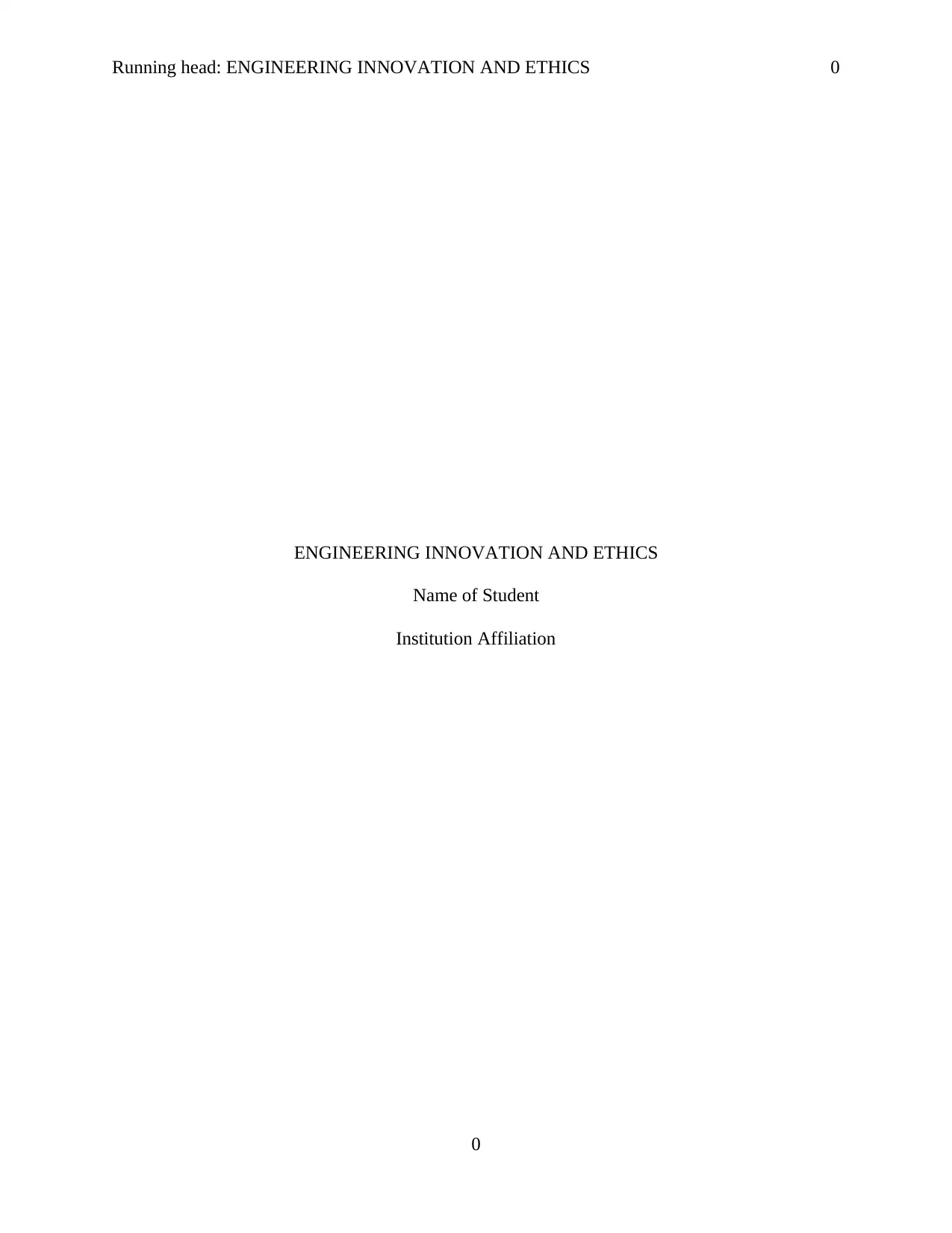
Running head: ENGINEERING INNOVATION AND ETHICS 0
ENGINEERING INNOVATION AND ETHICS
Name of Student
Institution Affiliation
0
ENGINEERING INNOVATION AND ETHICS
Name of Student
Institution Affiliation
0
Paraphrase This Document
Need a fresh take? Get an instant paraphrase of this document with our AI Paraphraser
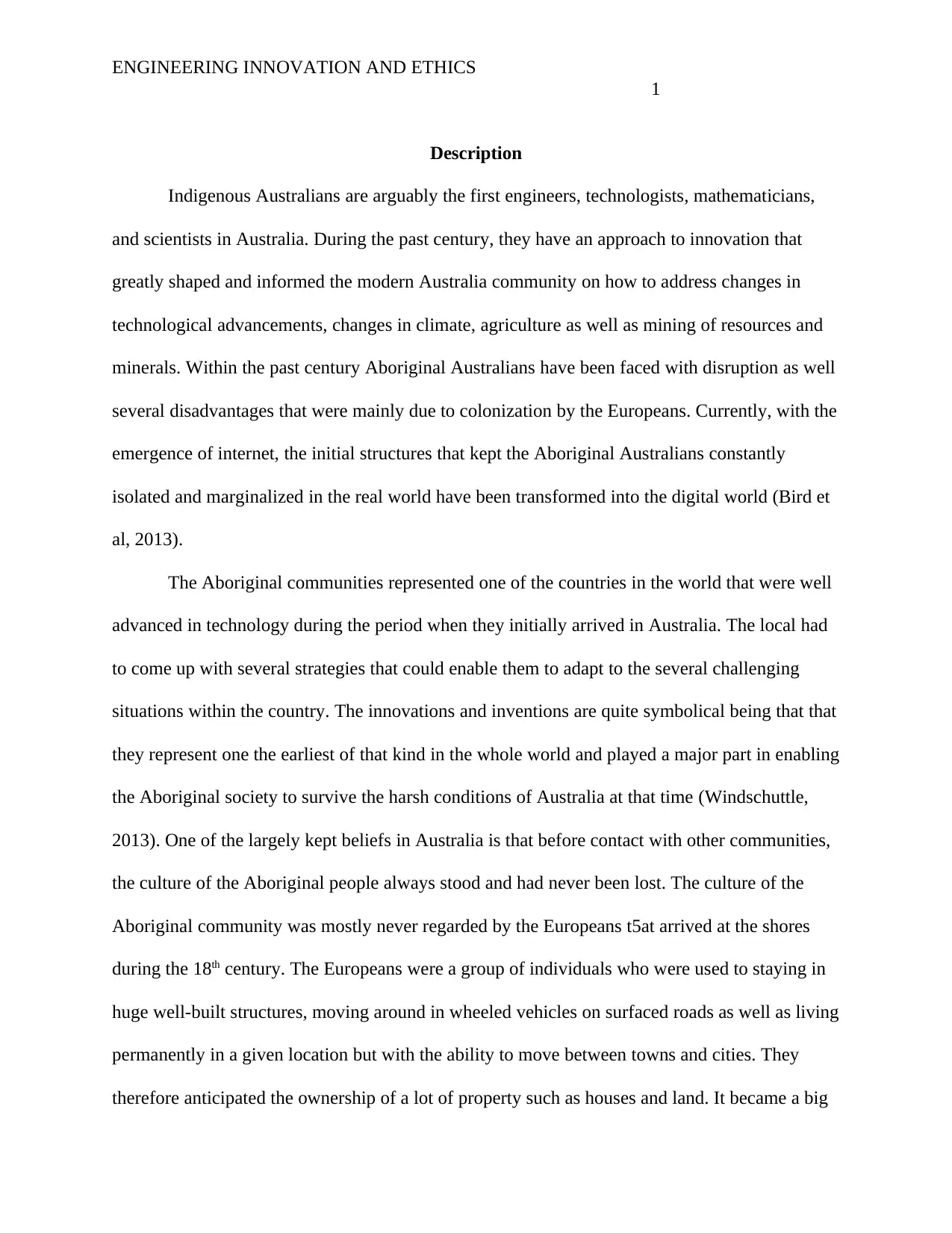
ENGINEERING INNOVATION AND ETHICS
1
Description
Indigenous Australians are arguably the first engineers, technologists, mathematicians,
and scientists in Australia. During the past century, they have an approach to innovation that
greatly shaped and informed the modern Australia community on how to address changes in
technological advancements, changes in climate, agriculture as well as mining of resources and
minerals. Within the past century Aboriginal Australians have been faced with disruption as well
several disadvantages that were mainly due to colonization by the Europeans. Currently, with the
emergence of internet, the initial structures that kept the Aboriginal Australians constantly
isolated and marginalized in the real world have been transformed into the digital world (Bird et
al, 2013).
The Aboriginal communities represented one of the countries in the world that were well
advanced in technology during the period when they initially arrived in Australia. The local had
to come up with several strategies that could enable them to adapt to the several challenging
situations within the country. The innovations and inventions are quite symbolical being that that
they represent one the earliest of that kind in the whole world and played a major part in enabling
the Aboriginal society to survive the harsh conditions of Australia at that time (Windschuttle,
2013). One of the largely kept beliefs in Australia is that before contact with other communities,
the culture of the Aboriginal people always stood and had never been lost. The culture of the
Aboriginal community was mostly never regarded by the Europeans t5at arrived at the shores
during the 18th century. The Europeans were a group of individuals who were used to staying in
huge well-built structures, moving around in wheeled vehicles on surfaced roads as well as living
permanently in a given location but with the ability to move between towns and cities. They
therefore anticipated the ownership of a lot of property such as houses and land. It became a big
1
Description
Indigenous Australians are arguably the first engineers, technologists, mathematicians,
and scientists in Australia. During the past century, they have an approach to innovation that
greatly shaped and informed the modern Australia community on how to address changes in
technological advancements, changes in climate, agriculture as well as mining of resources and
minerals. Within the past century Aboriginal Australians have been faced with disruption as well
several disadvantages that were mainly due to colonization by the Europeans. Currently, with the
emergence of internet, the initial structures that kept the Aboriginal Australians constantly
isolated and marginalized in the real world have been transformed into the digital world (Bird et
al, 2013).
The Aboriginal communities represented one of the countries in the world that were well
advanced in technology during the period when they initially arrived in Australia. The local had
to come up with several strategies that could enable them to adapt to the several challenging
situations within the country. The innovations and inventions are quite symbolical being that that
they represent one the earliest of that kind in the whole world and played a major part in enabling
the Aboriginal society to survive the harsh conditions of Australia at that time (Windschuttle,
2013). One of the largely kept beliefs in Australia is that before contact with other communities,
the culture of the Aboriginal people always stood and had never been lost. The culture of the
Aboriginal community was mostly never regarded by the Europeans t5at arrived at the shores
during the 18th century. The Europeans were a group of individuals who were used to staying in
huge well-built structures, moving around in wheeled vehicles on surfaced roads as well as living
permanently in a given location but with the ability to move between towns and cities. They
therefore anticipated the ownership of a lot of property such as houses and land. It became a big
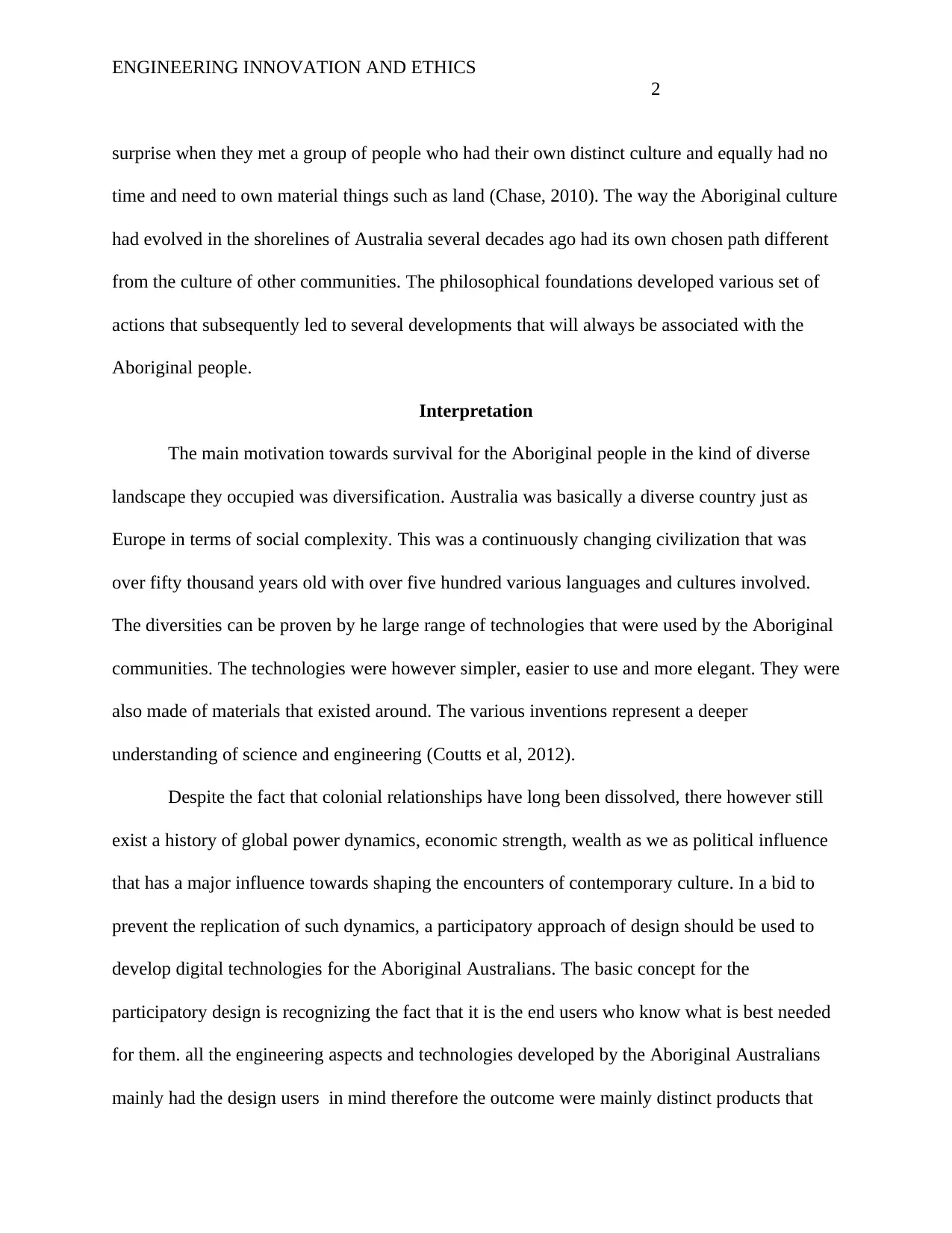
ENGINEERING INNOVATION AND ETHICS
2
surprise when they met a group of people who had their own distinct culture and equally had no
time and need to own material things such as land (Chase, 2010). The way the Aboriginal culture
had evolved in the shorelines of Australia several decades ago had its own chosen path different
from the culture of other communities. The philosophical foundations developed various set of
actions that subsequently led to several developments that will always be associated with the
Aboriginal people.
Interpretation
The main motivation towards survival for the Aboriginal people in the kind of diverse
landscape they occupied was diversification. Australia was basically a diverse country just as
Europe in terms of social complexity. This was a continuously changing civilization that was
over fifty thousand years old with over five hundred various languages and cultures involved.
The diversities can be proven by he large range of technologies that were used by the Aboriginal
communities. The technologies were however simpler, easier to use and more elegant. They were
also made of materials that existed around. The various inventions represent a deeper
understanding of science and engineering (Coutts et al, 2012).
Despite the fact that colonial relationships have long been dissolved, there however still
exist a history of global power dynamics, economic strength, wealth as we as political influence
that has a major influence towards shaping the encounters of contemporary culture. In a bid to
prevent the replication of such dynamics, a participatory approach of design should be used to
develop digital technologies for the Aboriginal Australians. The basic concept for the
participatory design is recognizing the fact that it is the end users who know what is best needed
for them. all the engineering aspects and technologies developed by the Aboriginal Australians
mainly had the design users in mind therefore the outcome were mainly distinct products that
2
surprise when they met a group of people who had their own distinct culture and equally had no
time and need to own material things such as land (Chase, 2010). The way the Aboriginal culture
had evolved in the shorelines of Australia several decades ago had its own chosen path different
from the culture of other communities. The philosophical foundations developed various set of
actions that subsequently led to several developments that will always be associated with the
Aboriginal people.
Interpretation
The main motivation towards survival for the Aboriginal people in the kind of diverse
landscape they occupied was diversification. Australia was basically a diverse country just as
Europe in terms of social complexity. This was a continuously changing civilization that was
over fifty thousand years old with over five hundred various languages and cultures involved.
The diversities can be proven by he large range of technologies that were used by the Aboriginal
communities. The technologies were however simpler, easier to use and more elegant. They were
also made of materials that existed around. The various inventions represent a deeper
understanding of science and engineering (Coutts et al, 2012).
Despite the fact that colonial relationships have long been dissolved, there however still
exist a history of global power dynamics, economic strength, wealth as we as political influence
that has a major influence towards shaping the encounters of contemporary culture. In a bid to
prevent the replication of such dynamics, a participatory approach of design should be used to
develop digital technologies for the Aboriginal Australians. The basic concept for the
participatory design is recognizing the fact that it is the end users who know what is best needed
for them. all the engineering aspects and technologies developed by the Aboriginal Australians
mainly had the design users in mind therefore the outcome were mainly distinct products that
⊘ This is a preview!⊘
Do you want full access?
Subscribe today to unlock all pages.

Trusted by 1+ million students worldwide
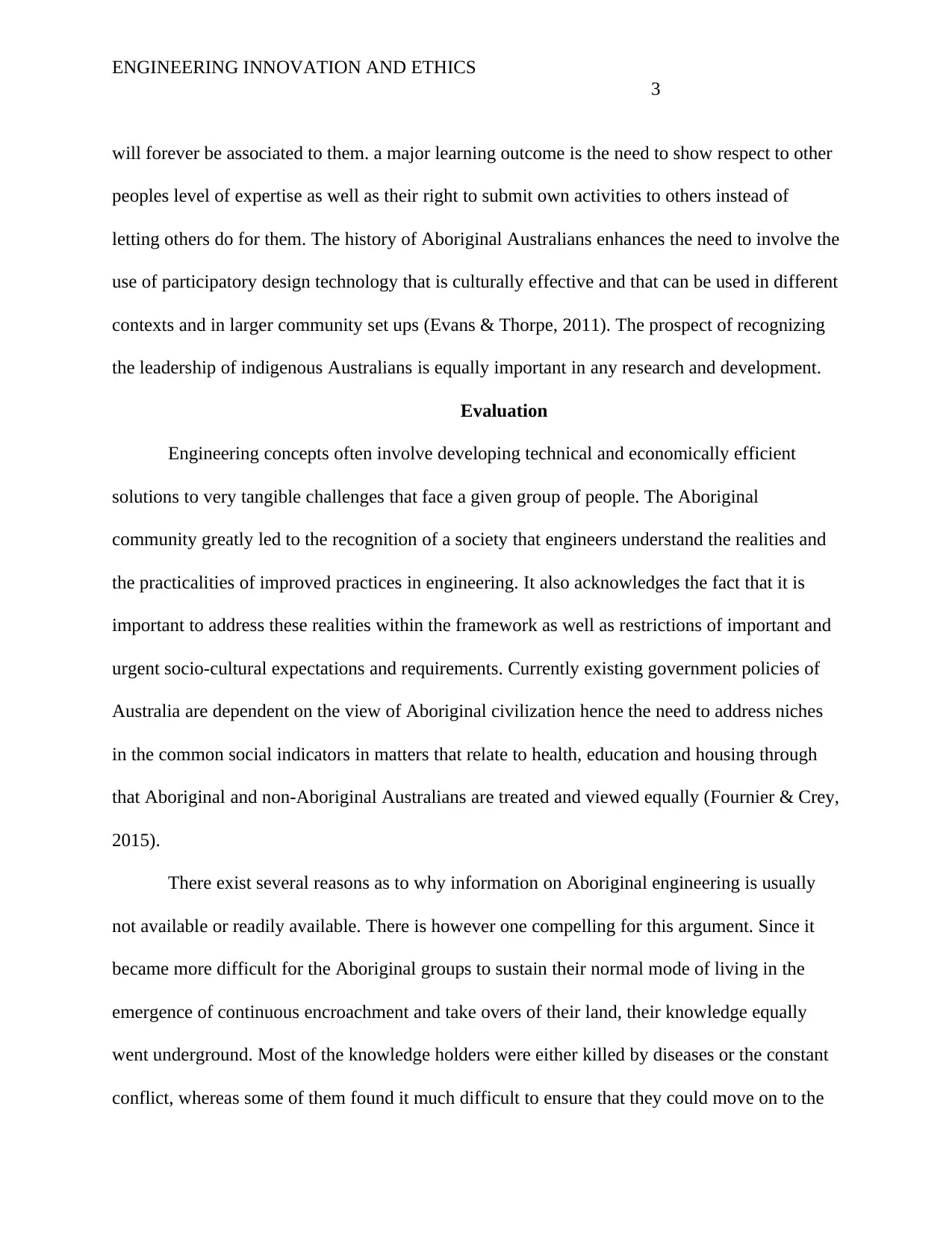
ENGINEERING INNOVATION AND ETHICS
3
will forever be associated to them. a major learning outcome is the need to show respect to other
peoples level of expertise as well as their right to submit own activities to others instead of
letting others do for them. The history of Aboriginal Australians enhances the need to involve the
use of participatory design technology that is culturally effective and that can be used in different
contexts and in larger community set ups (Evans & Thorpe, 2011). The prospect of recognizing
the leadership of indigenous Australians is equally important in any research and development.
Evaluation
Engineering concepts often involve developing technical and economically efficient
solutions to very tangible challenges that face a given group of people. The Aboriginal
community greatly led to the recognition of a society that engineers understand the realities and
the practicalities of improved practices in engineering. It also acknowledges the fact that it is
important to address these realities within the framework as well as restrictions of important and
urgent socio-cultural expectations and requirements. Currently existing government policies of
Australia are dependent on the view of Aboriginal civilization hence the need to address niches
in the common social indicators in matters that relate to health, education and housing through
that Aboriginal and non-Aboriginal Australians are treated and viewed equally (Fournier & Crey,
2015).
There exist several reasons as to why information on Aboriginal engineering is usually
not available or readily available. There is however one compelling for this argument. Since it
became more difficult for the Aboriginal groups to sustain their normal mode of living in the
emergence of continuous encroachment and take overs of their land, their knowledge equally
went underground. Most of the knowledge holders were either killed by diseases or the constant
conflict, whereas some of them found it much difficult to ensure that they could move on to the
3
will forever be associated to them. a major learning outcome is the need to show respect to other
peoples level of expertise as well as their right to submit own activities to others instead of
letting others do for them. The history of Aboriginal Australians enhances the need to involve the
use of participatory design technology that is culturally effective and that can be used in different
contexts and in larger community set ups (Evans & Thorpe, 2011). The prospect of recognizing
the leadership of indigenous Australians is equally important in any research and development.
Evaluation
Engineering concepts often involve developing technical and economically efficient
solutions to very tangible challenges that face a given group of people. The Aboriginal
community greatly led to the recognition of a society that engineers understand the realities and
the practicalities of improved practices in engineering. It also acknowledges the fact that it is
important to address these realities within the framework as well as restrictions of important and
urgent socio-cultural expectations and requirements. Currently existing government policies of
Australia are dependent on the view of Aboriginal civilization hence the need to address niches
in the common social indicators in matters that relate to health, education and housing through
that Aboriginal and non-Aboriginal Australians are treated and viewed equally (Fournier & Crey,
2015).
There exist several reasons as to why information on Aboriginal engineering is usually
not available or readily available. There is however one compelling for this argument. Since it
became more difficult for the Aboriginal groups to sustain their normal mode of living in the
emergence of continuous encroachment and take overs of their land, their knowledge equally
went underground. Most of the knowledge holders were either killed by diseases or the constant
conflict, whereas some of them found it much difficult to ensure that they could move on to the
Paraphrase This Document
Need a fresh take? Get an instant paraphrase of this document with our AI Paraphraser
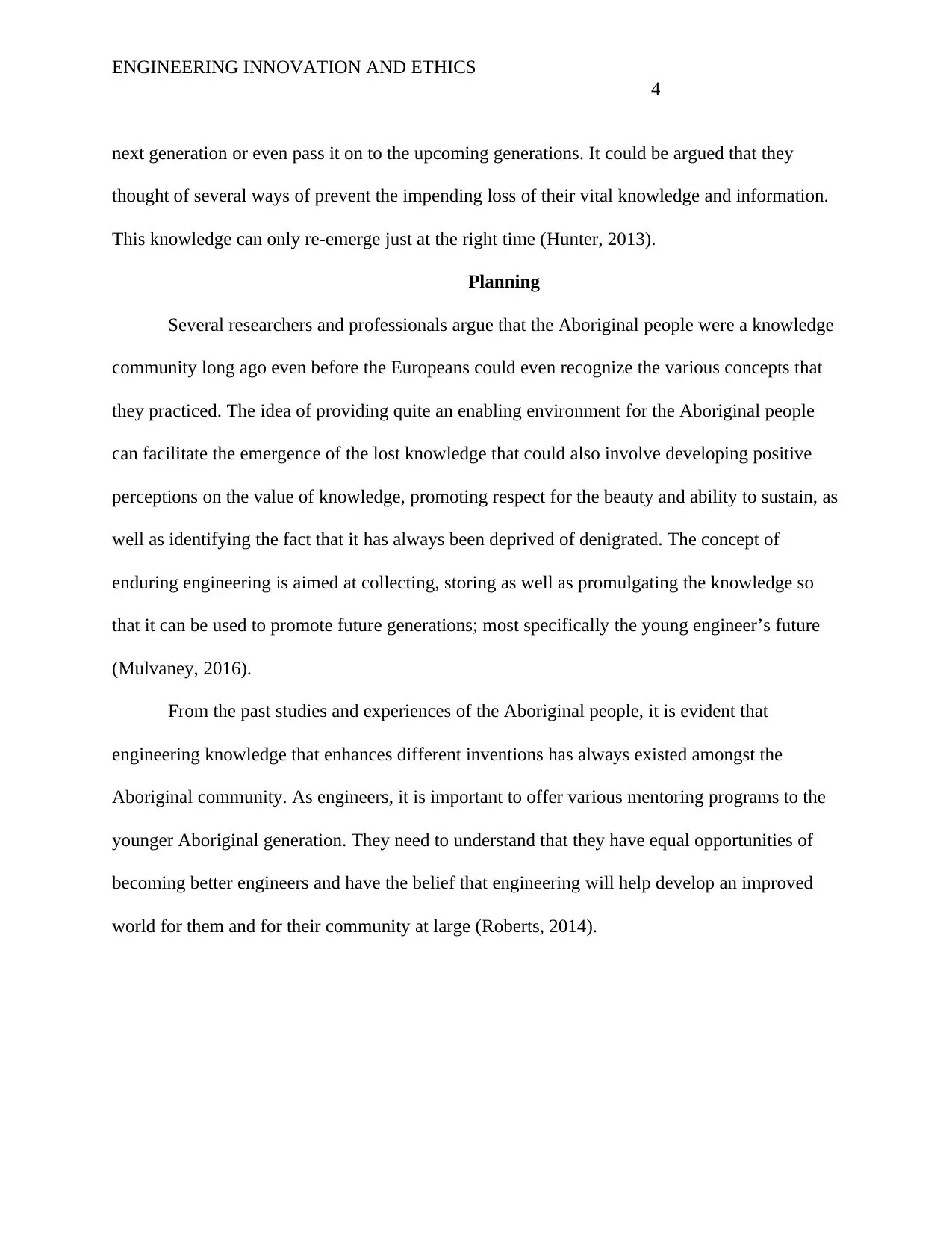
ENGINEERING INNOVATION AND ETHICS
4
next generation or even pass it on to the upcoming generations. It could be argued that they
thought of several ways of prevent the impending loss of their vital knowledge and information.
This knowledge can only re-emerge just at the right time (Hunter, 2013).
Planning
Several researchers and professionals argue that the Aboriginal people were a knowledge
community long ago even before the Europeans could even recognize the various concepts that
they practiced. The idea of providing quite an enabling environment for the Aboriginal people
can facilitate the emergence of the lost knowledge that could also involve developing positive
perceptions on the value of knowledge, promoting respect for the beauty and ability to sustain, as
well as identifying the fact that it has always been deprived of denigrated. The concept of
enduring engineering is aimed at collecting, storing as well as promulgating the knowledge so
that it can be used to promote future generations; most specifically the young engineer’s future
(Mulvaney, 2016).
From the past studies and experiences of the Aboriginal people, it is evident that
engineering knowledge that enhances different inventions has always existed amongst the
Aboriginal community. As engineers, it is important to offer various mentoring programs to the
younger Aboriginal generation. They need to understand that they have equal opportunities of
becoming better engineers and have the belief that engineering will help develop an improved
world for them and for their community at large (Roberts, 2014).
4
next generation or even pass it on to the upcoming generations. It could be argued that they
thought of several ways of prevent the impending loss of their vital knowledge and information.
This knowledge can only re-emerge just at the right time (Hunter, 2013).
Planning
Several researchers and professionals argue that the Aboriginal people were a knowledge
community long ago even before the Europeans could even recognize the various concepts that
they practiced. The idea of providing quite an enabling environment for the Aboriginal people
can facilitate the emergence of the lost knowledge that could also involve developing positive
perceptions on the value of knowledge, promoting respect for the beauty and ability to sustain, as
well as identifying the fact that it has always been deprived of denigrated. The concept of
enduring engineering is aimed at collecting, storing as well as promulgating the knowledge so
that it can be used to promote future generations; most specifically the young engineer’s future
(Mulvaney, 2016).
From the past studies and experiences of the Aboriginal people, it is evident that
engineering knowledge that enhances different inventions has always existed amongst the
Aboriginal community. As engineers, it is important to offer various mentoring programs to the
younger Aboriginal generation. They need to understand that they have equal opportunities of
becoming better engineers and have the belief that engineering will help develop an improved
world for them and for their community at large (Roberts, 2014).
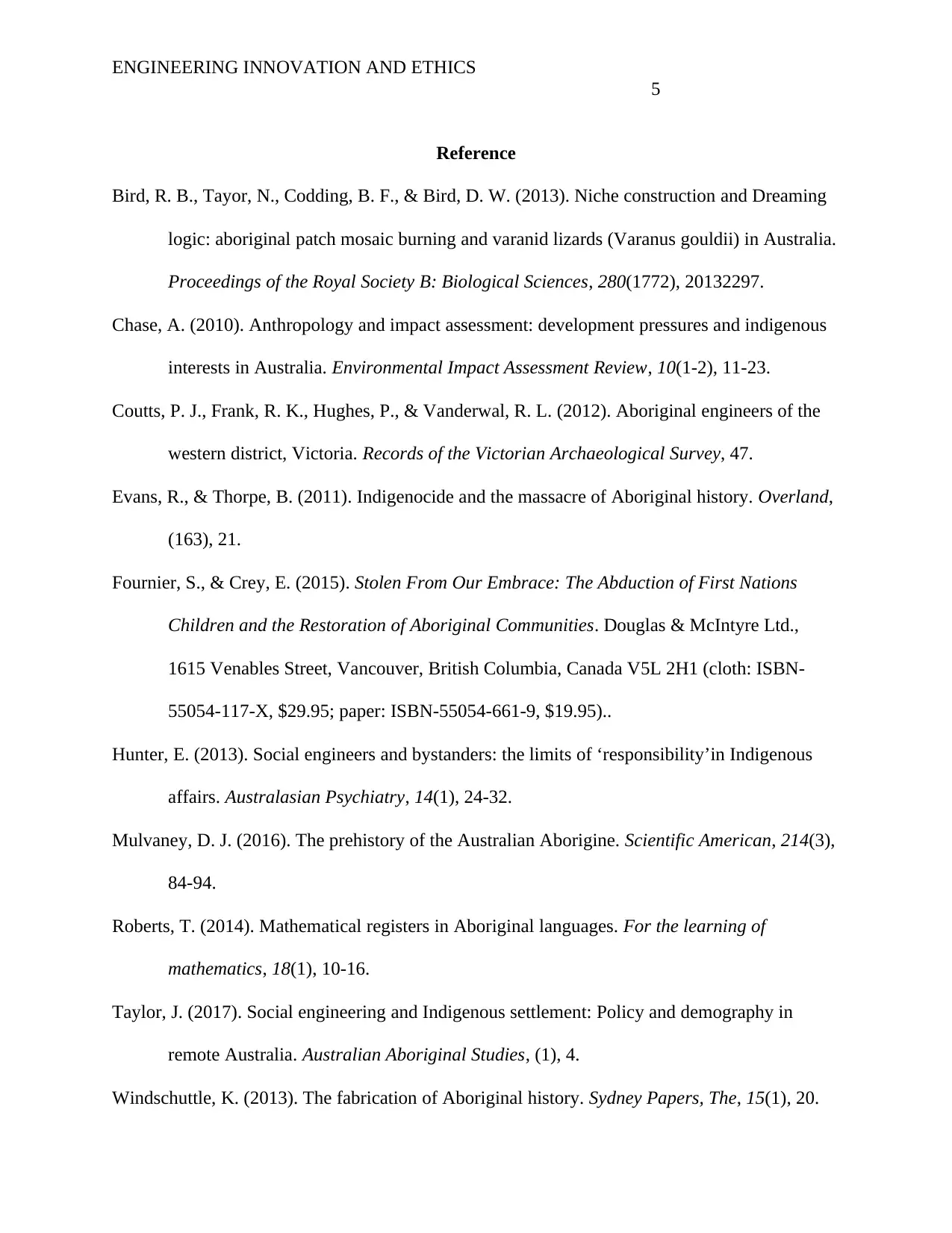
ENGINEERING INNOVATION AND ETHICS
5
Reference
Bird, R. B., Tayor, N., Codding, B. F., & Bird, D. W. (2013). Niche construction and Dreaming
logic: aboriginal patch mosaic burning and varanid lizards (Varanus gouldii) in Australia.
Proceedings of the Royal Society B: Biological Sciences, 280(1772), 20132297.
Chase, A. (2010). Anthropology and impact assessment: development pressures and indigenous
interests in Australia. Environmental Impact Assessment Review, 10(1-2), 11-23.
Coutts, P. J., Frank, R. K., Hughes, P., & Vanderwal, R. L. (2012). Aboriginal engineers of the
western district, Victoria. Records of the Victorian Archaeological Survey, 47.
Evans, R., & Thorpe, B. (2011). Indigenocide and the massacre of Aboriginal history. Overland,
(163), 21.
Fournier, S., & Crey, E. (2015). Stolen From Our Embrace: The Abduction of First Nations
Children and the Restoration of Aboriginal Communities. Douglas & McIntyre Ltd.,
1615 Venables Street, Vancouver, British Columbia, Canada V5L 2H1 (cloth: ISBN-
55054-117-X, $29.95; paper: ISBN-55054-661-9, $19.95)..
Hunter, E. (2013). Social engineers and bystanders: the limits of ‘responsibility’in Indigenous
affairs. Australasian Psychiatry, 14(1), 24-32.
Mulvaney, D. J. (2016). The prehistory of the Australian Aborigine. Scientific American, 214(3),
84-94.
Roberts, T. (2014). Mathematical registers in Aboriginal languages. For the learning of
mathematics, 18(1), 10-16.
Taylor, J. (2017). Social engineering and Indigenous settlement: Policy and demography in
remote Australia. Australian Aboriginal Studies, (1), 4.
Windschuttle, K. (2013). The fabrication of Aboriginal history. Sydney Papers, The, 15(1), 20.
5
Reference
Bird, R. B., Tayor, N., Codding, B. F., & Bird, D. W. (2013). Niche construction and Dreaming
logic: aboriginal patch mosaic burning and varanid lizards (Varanus gouldii) in Australia.
Proceedings of the Royal Society B: Biological Sciences, 280(1772), 20132297.
Chase, A. (2010). Anthropology and impact assessment: development pressures and indigenous
interests in Australia. Environmental Impact Assessment Review, 10(1-2), 11-23.
Coutts, P. J., Frank, R. K., Hughes, P., & Vanderwal, R. L. (2012). Aboriginal engineers of the
western district, Victoria. Records of the Victorian Archaeological Survey, 47.
Evans, R., & Thorpe, B. (2011). Indigenocide and the massacre of Aboriginal history. Overland,
(163), 21.
Fournier, S., & Crey, E. (2015). Stolen From Our Embrace: The Abduction of First Nations
Children and the Restoration of Aboriginal Communities. Douglas & McIntyre Ltd.,
1615 Venables Street, Vancouver, British Columbia, Canada V5L 2H1 (cloth: ISBN-
55054-117-X, $29.95; paper: ISBN-55054-661-9, $19.95)..
Hunter, E. (2013). Social engineers and bystanders: the limits of ‘responsibility’in Indigenous
affairs. Australasian Psychiatry, 14(1), 24-32.
Mulvaney, D. J. (2016). The prehistory of the Australian Aborigine. Scientific American, 214(3),
84-94.
Roberts, T. (2014). Mathematical registers in Aboriginal languages. For the learning of
mathematics, 18(1), 10-16.
Taylor, J. (2017). Social engineering and Indigenous settlement: Policy and demography in
remote Australia. Australian Aboriginal Studies, (1), 4.
Windschuttle, K. (2013). The fabrication of Aboriginal history. Sydney Papers, The, 15(1), 20.
⊘ This is a preview!⊘
Do you want full access?
Subscribe today to unlock all pages.

Trusted by 1+ million students worldwide
1 out of 6
Related Documents
Your All-in-One AI-Powered Toolkit for Academic Success.
+13062052269
info@desklib.com
Available 24*7 on WhatsApp / Email
![[object Object]](/_next/static/media/star-bottom.7253800d.svg)
Unlock your academic potential
Copyright © 2020–2025 A2Z Services. All Rights Reserved. Developed and managed by ZUCOL.





